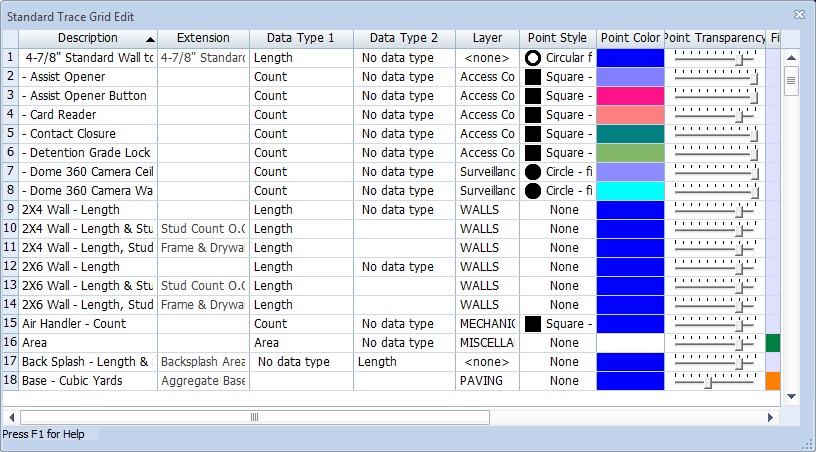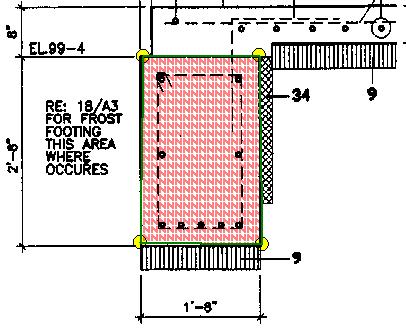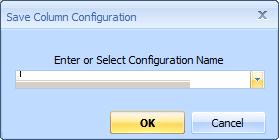Trace Grid Window
This window displays a list of all the standard traces in a grid with one row per trace and different columns for the trace properties.

Figure 1: The Trace Grid Window
All of the window is taken up by the trace grid. This grid shows all the standard traces.
Columns
At the top of the list are the column headings. The columns are highly configurable:
- You can change the width of a column by dragging the line at the end of the column heading.
- You can delete a column by right-clicking on the column heading and selecting "Delete" from the context menu.
- You can insert a column by right-clicking on the column heading, selecting "Insert column" from the context menu and selecting the desired column from the list.
- You can add columns to the end of the list by right-clicking the square area above the vertical scroll bar. Select "Add column" from the context menu, then select the desired column from the list.
- Once you have the columns configured for a particular purpose, you can save that configuration and re-load it latter.
The following columns are available:
- Description -
The primary use of trace descriptions in when selecting standard
traces from the Standard Trace Tree Window
or the Trace List/Tree Control.
Each standard trace must have a unique description.
When editing the trace for a measurement, this description is used to combine measurements in the Drawing Legend. To edit the description of the measurement itself, right-click on the measurement and select "Edit Description" from the Context Menu. - Extension - Select any of the Standard Extensions or "none" from the combo box. See Extensions Overview for more information on extensions. If an extension is selected, the quantity types can be set to any of the extension's fields.
- Data Type 1 -
When a trace is applied to a measurement, the Data Type 1 defines
the default dimension for the measurement (area, point count, length
or perimeter). If you drag and drop the measurement from the drawing
to another application, the default dimension is passed.
So if a measurement had a default of "area", when you dragged and dropped
the measurement to an Excel cell, the cell would be assigned the
measurement's area.
If an Extension has been selected for the trace, any of the extension's fields may be used for the data type. - Data Type 2 - 4 -
In some cases you may want to use several different quantities from the
same measurement. For example, the area might determine the carpet
required while the perimeter determines the base length.
In the trace, you can specify three additional data types (2-4) besides the first data type. These quantities can then be added as columns in the Measurement List. - Layer - Select the standard layer from the list. Layers allow you to show or hide selected measurements and annotations. For more information see the Standard Layer List Window.
- Description/Quantity Display -
Select one of the options for displaying the description
and/or quantity for measurements using this trace. The options are:
- No description or quantity display
- Display description
- Display quantity
- Display both description and quantity
- Display detail number only
The "quantity" displayed will be based on the first Data Type selected above. By default, the description/quantity is displayed in the center of the first group of non-disconnected points. To move the description for a measurement; follow the procedures to Edit Measurement Description then move the edit window to the desired location.
Note: With Premier you can use the Special Extension Variable Name ReplDesc to override the description with custom text. - Leader Size - The "leader" is a line drawn from the displayed description to the measurement. This is the thickness of the line. If it is zero, no line will be drawn. By default the line is drawn to the first point in the measurement. But when a measurement is selected, you can right-click on a point and select that as the point to be drawn to.
- Bid Code - You can enter a bid code manually or press the button to select a standard bid code from the Bid Code Lookup Window. If a standard bid code is selected, the bid code description will appear to the right of the button. Bid Code formatting and usage can be set up in the User Preferences.
- Negative Area Warning -
When a measurement's points are digitized in a counter-clockwise
direction, the area within the points is calculated as a negative amount.
This allows cutouts and other useful techniques. But it's possible
to unintentionally create a negative area, especially for novice users.
To avoid this problem, a distinctive pattern can be displayed
for negative areas.

Measurement with negative warning pattern displayed
This pattern will only be displayed when ALL of the following conditions are met:- The User Preference check box "Warn on negative areas" is checked.
- The trace's "Display negative area warning" checkbox is checked.
- The measurement doesn't have any disconnected points.
- The measurement points are digitized in a counter-clockwise direction.
This box will be checked by default if you select the "Area" data type or select a non-blank fill pattern. The box can be un-checked to eliminate the pattern for a particular measurement or for a standard trace. - Point Style - Select one of the symbols in the list to be displayed at each point of the measurement.
- Point Color - Press this button to select the color to be used for the symbol.
- Point Transparency - This slider controls the transparency of the symbol and text. Move it to the left for more transparency, to the right for less.
- Point Size -
Set the size of point symbols as a percentage. 100% makes
them about the size of 10 point text on the drawing.
Higher percentages make them larger, smaller percentages make them smaller.
Note: With Premier you can use the Special Extension Variable Names TracePointWidth, TracePointHeight and TracePointRadius to draw a fill colored rectangle or circle whose size matches the size of the object being counted. - Point Text - Enter any text that you want displayed near each point. If the text includes the percent sign (%), the point sequence number will be substituted for it. For example, if the text were "Pt%", then "Pt1", "Pt2", "Pt3", etc. would be displayed at the points.
- Point Text Color - Press this button to select the color to be used for the text. This includes any text displayed at points plus the description and the leader line.
- Point Text Size - Set the size of point text as a percentage. 100% makes the text about the size of 10 point text on the drawing. Higher percentages make it larger, smaller percentages make it smaller.
- Line Style - Select one of the line styles in the list to be drawn between the points of the measurement
- Line Color - Press this button to select the color to be used for the line
- Line Transparency - This slider controls the transparency of the lines. Move it to the left for more transparency, to the right for less.
- Line Width -
Select the width of the line in pixels. Line widths
only apply to solid lines
Note: With Premier you can use the Special Extension Variable Name TraceLineWidth to draw a fill colored line whose width matches the size of the object being measured. - Line Closed - Check this box if you want the last point in a group to be connected to the first point in a group.
- Line Curved - Check this box if you want lines between points to be curved. If this is checked, an arc Drawing User Preference "Default curved line degrees" will be used. During Advanced Point Editing you can drag the lines to the desired arc.
- Fill Style - Select one of the patterns in the list to fill the area inside the points of the measurement.
- Fill Color - Press this button to select the color to be used for the fill pattern.
- Fill Transparency - This slider controls the transparency of the fill. Move it to the left for more transparency, to the right for less.
- Folder - This is the traces folder name in the trace tree. Subfolders are separated using the "|" character.
- Work Breakdown Values - Once you have defined work breakdown categories, you can add those categories as columns in the grid and edit the trace's values. You can type the value into the control or press the down-arrow to select from the defaults for the category. If the category is locked, you may only use an existing default value. If the category is unlocked and you enter a new value, it will be added to the defaults for the category. See Work Breakdown Category Maintenance for more information on locking categories.
Saving and Re-loading Column Configurations
You will probably want to configure the columns differently for different purposes.
When you right-click in the column heading (any column), you will see the menu option "Save Column Configuration...". Select it and the Column Configuration Naming Window will appear.

Figure 2: The Column Configuration Naming Window
You can enter a name for the current configuration. If you wish to replace an existing configuration, you can press the down-arrow button and select from the list. Once you have entered a name, press the "OK" button and the configuration will be saved.
To re-load a saved configuration, right-click in the column heading and select "Load Column Configuration" from the menu. A sub-menu will appear listing the saved column configurations. Select a configuration and the columns will be set to match the configuration.
To delete a column configuration you no longer want, right-click in the column heading and select "Delete Column Configuration" from the menu. A sub-menu will appear listing the saved column configurations. Select a configuration and it will be deleted from the saved configurations
Resizing the Trace Grid Window
You can change the size of the measurement list window by dragging the edges or corners of the window or the Resizing Control in the lower right-hand corner of the window. The list will expand or contract to adjust to the new window size. Dimension will remember the window size and re-use it as you close and re-open the window.
Editing Multiple Properties for a Single Trace
If you want to edit the properties of a single trace using the Standard Trace Edit Window, put the focus on a cell in that row then right-click and select "Edit Trace" from the context menu.
Copying and Pasting Cells
The trace grid allows you to copy and paste cell values. The cell types must match for the paste to work. For example, you can't copy Point Colors into Point Styles.
The first step is to select a range of cells to copy. There are several ways to select cells:
- Select single cells by clicking on them.
- Select a rectangle of cells by selecting one corner, then holding the Shift key down while clicking on the opposite corner.
- Select a column by holding the Shift key down while clicking on the column heading. You can select a range of columns by selecting the starting column in the range, then selecting the ending column.
- Select a row by holding the Shift key down while clicking on the row heading (see Figure 1). You can select a range of rows by selecting the starting row in the range, then selecting the ending row.
- Select the entire grid by holding the Shift key down and clicking on the area above the row headings and to the left of the column headings.
Then right-click in the selected area and choose "Copy cells to Dimension Clipboard" from the context menu. The copied cells will be outlined with a green border
Then select the cells where you wish to paste. Use the same selection techniques described above.
Then right-click in the selected area and choose "Paste cells from the Dimension Clipboard" from the context menu.
